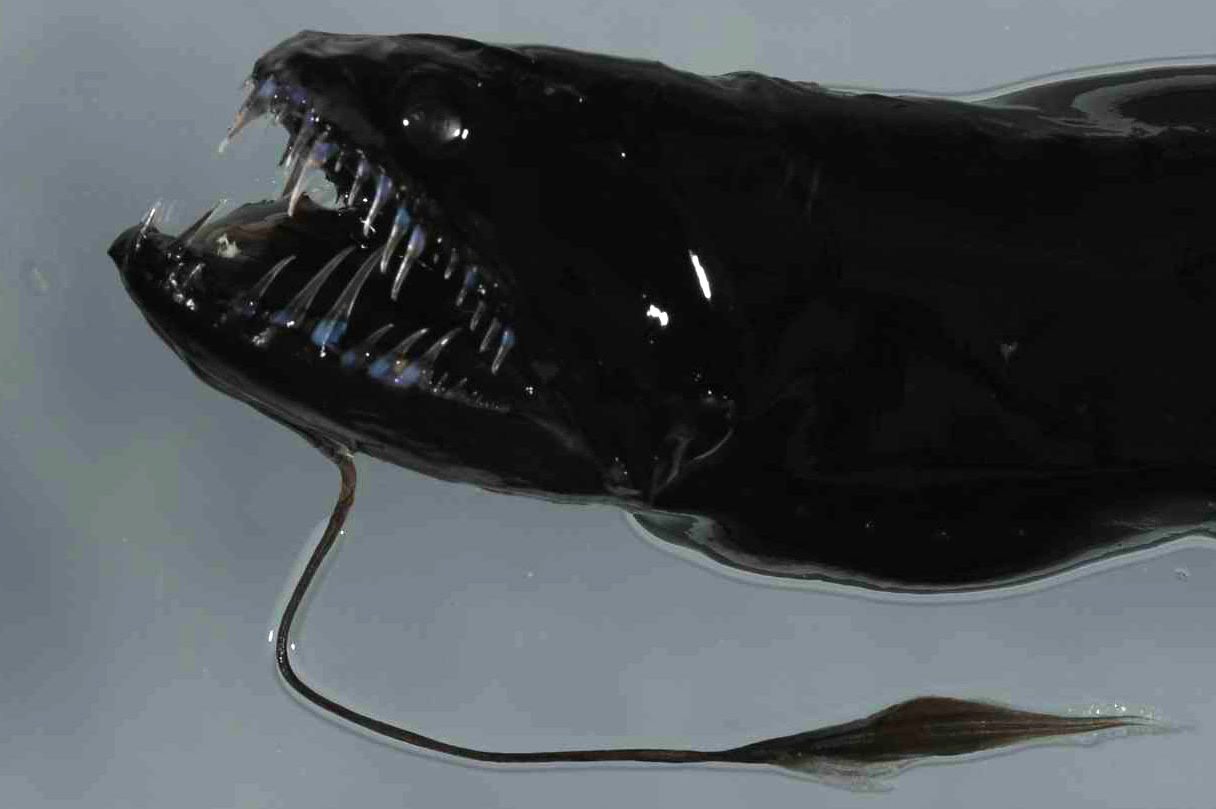Serpent Black Dragonfish, Idiacanthus fasciola Peters 1877
Other Names: Black Dragonfish, Gleaming-tailed Seadragon, Ribbon Sawtail Fish, Ribbon Saw-tail Fish, Serpent Dragon, Stalk-eyed Marvel

Head of a female Serpent Black Dragonfish, Idiacanthus fasciola, from the Tasman Sea. Source: Robin McPhee / NORFANZ Founding Parties. License: All rights reserved
Summary:
The slender black females have a long chin barbel with a bioluminescent tip, fang-like teeth, two rows of photophores along each lower side, and the dorsal-fin origin in advance of the pelvic-fin origin. The much smaller males have large eyes, a non-functional gut, and lack teeth, pelvic fins and a chin barbel.
Cite this page as:
Bray, D.J. 2019, Idiacanthus fasciola in Fishes of Australia, accessed 20 Apr 2024, https://fishesofaustralia.net.au/home/species/1811
Serpent Black Dragonfish, Idiacanthus fasciola Peters 1877
More Info
|
Distribution |
Off Tuncurry, New South Wales, to the South Tasman Rise, Tasmania, and off Rottnest Island to west of King Sound, Western Australia. Elsewhere the species is circumglobal in tropical and temperate waters. Inhabits mesopelagic and bathypelagic waters, usually in depths below 500 m. Females undertake daily vertical migrations, while the much smaller males occur in deeper waters. |
|
Features |
Females: Body extremely elongate, body depth approximately 2–6% SL; head small, 5–10% SL; mouth large, about equal to head in length; jaws with barbed, fang-like teeth; eye small, 1–3% of SL; chin barbel about twice head length, bioluminescent tip laterally compressed, unpigmented. Head and body covered with numerous small photophores; OA and IC photophores numerous, closely spaced; postorbital photophore much smaller than eye diameter. Skin smooth, black, scaleless. Pectoral fins absent; pelvic fins short, positioned at about midbody; dorsal-fin origin anterior to midpoint of body, well in advance of the anal-fin origin. |
|
Feeding |
Feeds mostly on fishes. |
|
Biology |
Males and females show marked sexual dimorphism. Males only grow to about 15% of the female body size, reaching a total length of about 4 cm, while females reach at least 35 cm in length. The males have large eyes, a non-functional gut, and lack teeth, pelvic fins and a chin barbel. The larvae are transparent fishes and have their eyes at the ends of long stalks. |
|
Similar Species |
Differs from Idiacanthus atlanticus in having the dorsal-fin origin behind the pelvic-fin origin and 19-23 photophores from pelvic-fin origin to anal-fin origin vs. dorsal-fin origin in advance of the pelvic-fin origin, and 14-16 photophores from pelvic-fin origin to anal-fin origin. |
|
Etymology |
|
|
Species Citation |
Idiacanthus fasciola Peters 1877, Monatsberichte der Königlichen Preussischen Akademie der Wissenschaften zu Berlin 1876: 847. Type locality: north of Australia and north of New Guinea [117°E and 1°04´05"N, 136°03´06"E]. |
|
Author |
Bray, D.J. 2019 |
|
Resources |
Serpent Black Dragonfish, Idiacanthus fasciola Peters 1877
References
Gibbs, R.H. Jr., 1984. Idiacanthidae. p. 371-372. In P.J.P. Whitehead, M.-L. Bauchot, J.-C. Hureau, J. Nielsen & E. Tortonese (eds) Fishes of the north-eastern Atlantic and the Mediterranean. UNESCO, Paris. Vol. 1.
Harold, A. 2015. Idiacanthus fasciola. The IUCN Red List of Threatened Species 2015: e.T18257198A21909419. http://dx.doi.org/10.2305/IUCN.UK.2015-4.RLTS.T18257198A21909419.en. Downloaded on 12 February 2016.
Hulley, P.A., 1986. Idiacanthidae. p. 234-235, in Smith, M.M. & Heemstra, P.C. (eds). Smith's Sea Fishes. Johannesburg : Macmillan South Africa xx + 1047 pp. 144 pls.
Nakabo, T. (ed.) 2002. Fishes of Japan with pictorial keys to the species. English edition.. Tokyo : Toikai University Press Vol. 1 pp.1-866.
Peters, W.C.H. 1877. Übersicht der während der von 1874 bis 1876 unter dem Kommando des Hrn. Kapitän z. S. Freiherrn von Schleinitz ausgeführten Reise S.M.S. Gazelle gesammelten und von der Kaiserlichen Admiralität der Königlichen Akadamie der Wissenschaften äbersandte Fische. Monatsberichte der Königlichen Preussischen Akademie der Wissenschaften zu Berlin 1876: 831-854.
Scott, E. 1979. Observations on some Tasmanian fishes : Part XXV. The Royal Society of Tasmania 113: 99-105.
Stewart, A.L. & Kenaley, C.P. 2015. Systematic Accounts. Family Stomiidae, 68 Subfamily Astronesthinae (471-486), Family Stomiidae, 72 Subfamily Idiacanthinae (521-523). In: C.D. Roberts, A.L. Stewart & C.D. Struthers (eds). The Fishes of New Zealand 2: 1-574.
Sutton, T.T. & Hopkins, T.L. 1996. Species Composition, Abundance, and Vertical Distribution of the Stomiid (Pisces: Stomiiformes) Fish Assemblage of the Gulf of Mexico. Bulletin of Marine Science 59(3): 530-542.
Whitley, G.P. 1966. Marine Fishes of Australia. Brisbane : Jacaranda Press Vol. 1 pp. 1-142.








